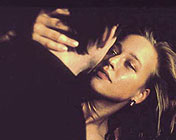|
|
|
|
Winter
Sleepers
|
 |
|
Love Colder Than Death The galloping success of Run Lola Run (1998) has spurred the release, in several countries, of an earlier film directed, co-written and co-scored by Tom Tykwer: Winter Sleepers (1997). Although obviously the work of a talented and careful filmmaker, this movie lacks the abundant energy and inventiveness of Run Lola Run. Rather than tipping his hat to techno culture and music video, Tykwer here repays his debts to the classical masters – especially Fritz Lang and Alfred Hitchcock. Winter Sleepers is a severely formal exercise, in which every plot twist raises an ethical problem of guilt or innocence, and even the underwear and pyjamas worn by the characters fit a precise, colour-coded scheme. Tykwer belongs to a tradition in cinema that includes Chabrol, De Palma, Dario Argento, the Hitchcock of Strangers on a Train (1951), as well as, inaugurally and pre-eminently, Lang: formalists working within popular modes (thriller, mystery, action) who (as Michael Henry once put it) express in order to create, rather than create in order to express. That is to say, they fix on particular plots, characters and themes as an opportunity to enjoy fashioning a certain geometry of cinematic design (in time as in space). For films in this tradition, meaning – in the traditional thematic and literary sense – is secondary, a mere pretext. The shape of a theme, its surface manifestations, the manoeuvres necessary to achieve its fulfilment, matter more than its expressive depths. This is why such films are so often dismissed as cold, impersonal, heartless. Hence, also, their prevalent obsession with doppelgängers, twins, mirror imagery, the reversibility of good and evil, the thin line between madness and sanity: skin-deep tropes evident in hundreds of mediocre horror-thrillers, certainly, but capable of generating, in the right hands, a frisson of formal calculation and play. Since the early '70s, pop formalism and film theory have, now and again, perfectly bonded. In a 1974 issue of the British magazine Monogram, for example, Mark Le Fanu suggested: "What we notice about [Chabrol's symbols] above all is their extreme and formal symmetry, the wealth of variations on the stock opposition – in short, their formal disposition. They are signs which exist in a quasi-autonomous role, forms without meaning in a circular discourse. We are witnessing a movement away from the sign meaning something to a situation where the sign refers only to other signs, other fictions (...) Chabrol's later films offer – in the Joycean phrase – a 'hesitation' of meaning, a hovering of sense in the interests of structural concerns, a deliberate separation of the real world from the 'reel world'". Winter Sleepers, although not an especially distinguished contribution to this tradition, is definitely constructed upon the 'extreme and formal symmetry' of its surface signs, in order to form an utterly enclosed, Langian mechanism. In the deliberately jumbled confusion of its opening scenes, there is a crime, a dead body, an abandoned car and a hot tryst. From that highpoint the movie goes steadily downhill. Much of the action is centred on a house in which the troubled, macho Marco (Heino Ferch) alienates his girlfriend, Rebecca (Floriane Daniel), while the uptight Laura (Marie-Lou Sellem) gravitates toward the enigmatic and amnesiac Rene (Ulrich Matthes). The sole interest of this plot lies in the numerous, dramatic ironies arranged by chance, coincidence and fate. But the film takes an awfully long time working out its fairly predictable narrative pattern. Tykwer's interest seems to be elsewhere: for instance, in the visual rhymes (borrowed from Hitchcock's Spellbound, 1945) that link a table fork, tyre marks and tracks in the snow. There is something about snow that induces many filmmakers into a soporific state of contemplation. Distant figures trudge slowly through obscuring mists, while music swirls and circles to mimic the motion of snowflakes – and, of course, every scene must end with a blinding fade to white. Think Fargo (1996), Affliction (1998), The Sweet Hereafter (1997), Snow Falling on Cedars (1999). To give this wintry mood a further, funereal pallor, Tykwer fills his film with endless shots of people sleeping, fainting or simply zoning out. Languor infects every limb of these characters. In a memorably exaggerated climax, a character's fall from a snowy slope seems to last for an eternity. Doubtless – as a mean hombre once said in a Sergio Leone Western – it all has "something to do with death". © Adrian Martin March 2000 |
![]()